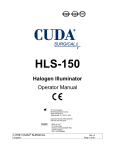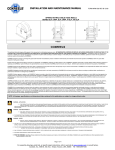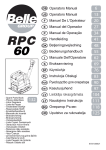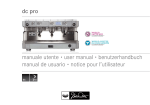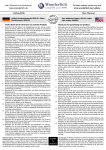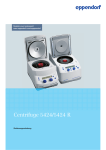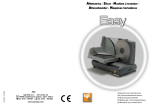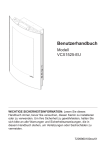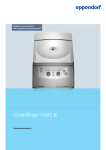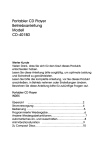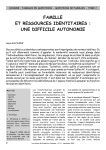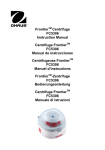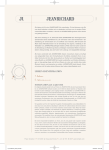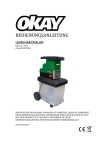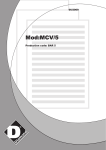Download - Coxreels
Transcript
INSTALLATION AND MAINTENANCE MANUAL FORM #PM-003 REV D 11/09 HAND CRANK HOSE/CABLE REELS: SERIES: SDH, 112, 117, CM, DM, SM, 1125, 1125WC, 1275-C, 1275W-C V-1175, VA-1175, 1175-6, 1185 & 1195 SERIES: 112,117 SERIES: CM SERIES: DM SERIES: SM SERIES: 1125, 1125WC 1175-6, 1185, 1195 SERIES: V1175 VA-1175 SERIES: 1275-C 1275W-C COXREELS The technical data and images which appear in this manual are for informational purposes only. NO WARRANTIES, EXPRESS OR IMPLIED, INCLUDING WARRANTIES OF MERCHANTABILITY OR FITNESS FOR A PARTICULAR PURPOSE, ARE CREATED BY THE DESCRIPTIONS AND DEPICTIONS OF THE PRODUCTS SHOWN IN THIS MANUAL. COXREELS makes no warranty (and assumes no liability) as to function of equipment or operation of systems built according to customer design or of the ability of any of its products to interface, operate or function with any portions of customer systems not provided by COXREELS. COXREELS agrees to repair or exchange the goods sold hereunder necessitated by reason of defective workmanship and material discovered and reported COXREELS within two years after shipment of such goods to Buyer. Except where the nature of the defect is such that it is appropriate, in COXREELS’ judgment, to effect repairs on site, COXREELS’ obligation hereunder to remedy defects shall be limited to repairing or replacing (at COXREELS’ option) FOB point of original shipment, any part returned to COXREELS at the risk and cost of Buyer. Defective parts replaced shall become the property of COXREELS. COXREELS shall only be obligated to make such repair or replacement if the goods have been used by Buyer only in service recommended. COXREELS is not responsible for defects which arise from improper installation, neglect, improper use of or from normal wear and tear. COXREELS obligation shall be limited by the manufacturer’s warranty (and is not further warranted by COXREELS) for all parts procured from others according to published data, specifications or performance information not designed by COXREELS. COXREELS further agrees to replace or at COXREELS’ option to provide a refund of the sales price of any goods that do not conform to applicable specifications or which differ from that agreed to be supplied which non-conformity is discovered and forthwith reported to COXREELS within 30 days after shipment to the Buyer. COXREELS’ obligation to replace or refund the purchase price for nonconforming goods shall arise once Buyer returns such goods FOB point of original shipment by COXREELS at the risk and cost of Buyer. Goods replaced by COXREELS shall become property of COXREELS. COXREELS liability on any claim, whether in contract, tort (including negligence), or otherwise, for any loss or damage arising out of, connected with, or resulting from the manufacture, sale, delivery, resale, repair, replacement or use of any products or services shall in no case exceed the price paid for the product or services or any part thereof which give rise to the claim. In no event shall COXREELS be liable for consequential, special, incidental or other damages, nor shall COXREELS be liable in respect of personal injury or damage to property not the subject matter hereof unless attributable to gross misconduct of COXREELS, which shall mean an act or omission by COXREELS demonstrating reckless disregard of the foreseeable consequences thereof. COXREELS is not responsible for incorrect choice of models or where products are used in excess of their rated and recommended capacities and design functions or under abnormal conditions. COXREELS assumes no liability for loss of time, damage or injuries to property or persons resulting from the use of COXREELS products. Buyer shall hold COXREELS harmless from all liability, claims, suits and expenses in connection with loss or damage resulting from operation of products or utilization of services, respectively, of COXREELS and shall defend any suit or action which might arise there from in Buyer’s name – provided that COXREELS shall have the right to elect to defend any such suit or action for the account of Buyer. The foregoing shall be the exclusive remedies of the Buyer and all persons and entitles claiming through the Buyer. NOTE: All designs, specifications, and dimensional data contained in this publication are subject to change without notice. WARNING – APPLICATION THE PRODUCTS IN THIS INSTALLATION AND MAINTENANCE MANUAL HAVE BEEN TESTED UNDER CONTROLLED LABORAROTY CONDITIONS TO MEET SPECIFIC TEST CRITERIA. THESE TESTS ARE NOT INTENDED TO REFLECT THE PERFORMANCE OF THE PRODUCTS OR ANY OTHER MATERIAL IN ANY SPECIFIC APPLICATION, BUT ARE INTENDED TO PROVIDE THE USER WITHY APPLICATION GUIDELINES. THE PRODUCTS ARE INTENDED FOR USE BY KNOWLEDGEABLE PERSONS HAVING THE TECHNICAL SKILL NECESSARY TO EVALUATE THEIR SUITABILITY FOR SPECIFIC APPLICATIONS. WARNING – USER RESPONSIBILITY THE USER, THROUGH ITS OWN ANALYSIS AND TESTING, IS SOLELY RESPONSIBLE FOR MAKING THE FINAL SELECTION OF THE SYSTEM AND COMPONENTS AND ASSURING THAT ALL PERFORMANCE, ENDURANCE, MAINTENANCE, SAFETY AND WARNING REQUIREMENTS OF THE APPLICATION ARE MET. TO THE EXTENT THAT COXREELS PROVIDE COMPONENT OR SYSTEM OPTIONS BASED UPON DATA OR SPECIFICATIONS PROVIDED BY THE USER, THE USER IS RESPONSIBLE FOR DETERMINING THAT SUCH DATA AND SPECIFICATIONS ARE SUITABLE AND SUFFICIENT FOR ALL APPLICATIONS AND REASONABLY FORESEEABLE USES OF THE COMPONENTS OR SYSTEM. WARNING – SAFETY READ ALL SAFETY INSTRUCTIONS CAREFULLY BEFORE ATTEMPTING TO INSTALL, OPERATE, OR MAINTAIN THIS PRODUCT. ONLY QUALIFIED PERSONNEL SHOULD UNDERTAKE THE INSTALLATION AND COMMISSIONING OF THIS PRODUCT. FAILURE TO COMPLY WITH INSTRUCTIONS COULD RESULT IN PERSONAL INJURY AND/OR PROPERTY DAMAGE. FAILURE TO FOLLOW RECOMMENDED APPLICATION INFORMATION AND RECOMMENDED PROCEDURES FOR SELECTION, INSTALLATION, CARE, MAINTENANCE AND STORAGE OF REEL ASSEMBLY, SWIVEL, HOSE, COUPLINGS OR HOSE ASSEMBLIES MAY RESULT IN FAILURE TO PERFORM PROPERLY AND MAY RESULT IN DAMAGE TO PROPERTY AND SERIOUS BODILY INJURY. FOLLOW GOOD MAINTENANCE PRACTICES – ESTABLISH A PROGRAM OF INSPECTION, TESTING AND REPLACEMENT OF REEL COMPONENTS FROM FACTORS INCLUDING: o SEVERITY OF APPLICATION, FREQUENCY OF EQUIPMENT USE, AND PAST PERFORMANCE OF REEL COMPONENTS ONLY PROPERLY TRAINED PERSONS SHOULD INSPECT, TEST OR SERVICE REEL AND HOSE/CABLE ASSEMBLIES. PERIODIC UPDATING OF TRAINING IS RECOMMENDED. DOCUMENT MAINTENANCE, INSPECTIONS AND TESTING. PROP 65 WARNING: Handling of brass material on this product exposes you to lead, a chemical known to the State of California to cause birth defects or other reproductive harm. “WASH HANDS AFTER USE” Page 1 of 4 For assembly drawings, parts lists, or specific repair instructions, refer to web site at www.coxreels.com or consult factory. Coxreels, Inc., 5865 S. Ash Ave., Tempe, Arizona, USA, 85283 Tel: 1-800-269-7335 INSTALLATION AND MAINTENANCE MANUAL FORM #PM-003 REV D 11/09 SAFETY • Operational temperature ranges vary across the wide range of hose options. (Please refer to the COXREELS catalog, website or contact Customer Service for hose specific data). Hose reels should not be used at temperatures below or above the rating of the hose. The operational rating of a reel not equipped with hose is determined by the capacity of the installed hose. The pressure rating of the reel without hose must not be greater than the than the operational capacity of a reel. (Please refer to the COXREELS catalog, website or contact Customer Service for reel/hose specific data). Variations in the OD of higher rated hose will affect the operational capacity of the reel. PRESSURE WARNINGS • • • This equipment should be properly installed before use in accordance with local codes and ordinances. The pressure from the hose reel should be disconnected from the hose reel before any service functions are performed. This hose reel must not be used for pressure greater that the rating listed in the COXREELS catalog / website www.coxreels.com. • OPERATIONAL WARNINGS • • • • Exercise care when handling the hose reel during normal operation. Do not use hose different from that for which the reel is intended. Changes in diameter, weight per foot, length of hose or flexibility (Minimum Bend Radius) will affect the operation of the reel. Mounting hardware and fasteners should be installed to maintain tightness under vibration and checked periodically to ensure tightness. Overhead installation mountings should be such that the reel is not supported by bolts in tension. A safety chain, cable, enclosure or netting is strongly recommended to minimize damage and/or possible injury in the event of a mounting failure. LABELS & MARKINGS Hose Reels with and without hose • The marking of the hose reel provide with or without hose includes the following o The label on the frame includes the COXREELS name and Logo, the product catalog number, the individual product serial number, PSI rating and what type and length of hose intended for use on the reel. o The maximum pressure rating for every hose reel supplied without house is marked on the COXREELS Identification Label. In absence of this information, refer to website, catalog, or customer service. Actual rating is determined by the installed hose and is not to exceed the indicated maximum operational rating. The pressure rating of the hose installed on reels provided without hose must be marked on the label upon installation. MAINTENANCE WARNINGS • Modification of the equipment may cause excessive wear and will void the warranty. Contact COXREELS regarding changes or modifications of equipment which could affect reliability or safety. SPECIFICATIONS & LISTINGS • • PERSONAL SAFETY The identified Series of Hose Reel products within this manual are not certified or listed by any independent certifying or regulatory body. This series of hose reels is intended for industrial use and are provided with permanent mounting means. • • Ensure reel has been properly installed before connecting supply line. Before connecting to reel, be certain supply line does not exceed rated pressure of the hose reel or amperage rating on cable reel. Thoroughly review the “Hose Installation” instructions to properly install hose. Perform “Operational Check” per instructions to ensure reel is operating properly. If a leak should occur after applying pressure to the reel, immediately discontinue supply line pressure. • PRESSURE & TEMPERATURE RATING • • • All reels covered in this manual with or without hose have specific P.S.I. ratings. (Please refer to the COXREELS catalog, website or contact Customer Service for Reel specific data). Reels should not be used at pressures greater that the rating of the hose. Multipurpose hose is installed with tube compounded for maximum oil resistance. Hose can be used for air, water, oil and many other chemical applications. • WARNING: Prevent static sparking. When working around flammables, ensure that the hose reel, hose, and equipment are properly grounded. INSTALLATION MOUNT REEL / FASTEN CRANK HANDLE • • • • To mount reel to a solid structure use 7/16” or M12 bolts, washers, and nuts. Masonry bolts may be used depending on mounting application. Mounting hardware is NOT provided. Mounting patterns will vary depending on model. NOTE: If you choose to permanently mount series CM, you will need four ¼” screws or nails. Fit mounting hardware to ceiling/wall/floor so reel can be fastened into position. Fit reel and tighten all hardware securely. Reels are supplied with plastic crank handle uninstalled. Remove handle and hardware from plastic bag and install onto crank arm. Models 1275 and 600-900 will include detachable crank for bevel gear design. The series DM portable reels will include a U-shaped handle. Position handle over swaged posts and fasten using hardware provided. INSTALLATION OF INLET HOSE • Apply thread sealant to inlet hose and connect to the swivel joint on reel. CAUTION: IT IS IMPORTANT TO USE A “FLEXIBLE” INLET HOSE. DO NOT USE SOLID PIPING OR RESTRAIN INLET HOSE AS TO CAUSE ANY SIDE FORCE ON SWIVEL JOINT. THE WARRANTY IS VOID IF NOT PROPERLY INSTALLED. • • Flush some product through the system before connecting inlet hose to the source. Connect end to supply source. Page 2 of 4 For assembly drawings, parts lists, or specific repair instructions, refer to web site at www.coxreels.com or consult factory. Coxreels, Inc., 5865 S. Ash Ave., Tempe, Arizona, USA, 85283 Tel: 1-800-269-7335 INSTALLATION AND MAINTENANCE MANUAL FORM #PM-003 REV D 11/09 INSTALLATION OF OUTLET HOSE • • NOTE: Before proceeding, ensure that you are installing the proper size, length and type of hose that the reel is rated for. Consult factory if unsure of rating. • • • • Wind hose on to reel. Hold onto crank handle and turn. The operator should hand guide the hose on to reel to achieve maximum capacity. Flush fluid through system. Inspect hose, connections, and swivel for leaks. INSTALLATION OF CABLE (1125WC SERIES) Securely install hose reel prior to installing outlet hose. Apply thread sealant to male hose fitting and insert into the drum opening. Note: It is recommended that a swivel type connector be used to ease installation of outlet hose. Thread male hose fitting into outlet riser(s) (Refer to FIGURE 1.0). Challenger series 100W Using a wrench, firmly hold on to riser fitting while tightening hose connector. NOTE: Before proceeding, ensure that you are installing the proper size, length and type of cable that the reel is rated for. Refer to label to determine amperage rating. CAUTION: ENSURE THAT THE CABLE CONNECTOR IS SECURELY CRIMPED, SOLDERED, OR CLAMPED TO CABLE. NOTE: The hose clamp restrains the hose when fully extended, preventing strain on the fitting. • • CAUTION: FULLY EXTEND AND CHARGE HOSE BEFORE INITIALLY WINDING ON TO REEL. THIS PREVENTS FLATTENING OF HOSE AND EXCESSIVE PRESSURE ON DRUM WHEN HOSE IS FULLY CHARGED DURING OPERATION. • Place connector over stud (FIGURE 2.0) and install brass nut (supplied). Using a wrench, firmly hold onto the nut under the connector while tightening the outer nut. Connect the supply line in the same manner. FIGURE 1.0 FIGURE 2.0 DO NOT OVER TIGHTEN! CAUTION: ENSURE THAT ALL OPERATION CHECKS HAVE BEEN COMPLETED BEFORE RELEASING FOR USE. • Reconnect inlet hose and test for leakage. OPERATIONAL CHECK • • Check for correct operation by pulling out some of the hose/cable. A slight friction or drag should be noticed. This drag is to prevent backlash when pulling out hose/cable. Adjust drag brake. Turn clockwise to add tension and counterclockwise to decrease tension. See figures 3.0-6.0. NOTE: Swivels designs vary depending on the reel model. Refer to repair procedure shipped with individual seal replacement kits or consult factory. CAUTION: Release line pressure prior to making repairs or adjustments to reel. SWIVEL SEAL REPLACEMENT SLIP RING BRUSH REPLACEMENT (1125WC SERIES) • • • • • Remove inlet hose from swivel. Remove swivel from reel by unscrewing swivel from reel axle. Disconnect hose from swivel. Remove retaining ring on swivel; pull out spool from body. Replace the seals, Apply O-ring lubricant and reassemble swivel. Fit hose to swivel then fit swivel to reel. • • • • • Remove cable completely from drum of reel. Remove access panel on drum by removing four screws. Remove brush retaining nut to access worn brushes. Replace with new copper brushes. Reverse above procedure to re-assemble reel. Page 3 of 4 For assembly drawings, parts lists, or specific repair instructions, refer to web site at www.coxreels.com or consult factory. Coxreels, Inc., 5865 S. Ash Ave., Tempe, Arizona, USA, 85283 Tel: 1-800-269-7335 INSTALLATION AND MAINTENANCE MANUAL FORM #PM-003 REV D 11/09 FIGURE 4.0 (112, 117, CM & DM TROUBLE SHOOTING GUIDE TROUBLE CAUSE REMEDY HOSE/CABLE WILL NOT FULLY FIT ON TO DRUM OF REEL a) Hose/cable is longer than specified. b) Outside diameter of hose is larger than specification. c) Hose/cable was not hand guided onto reel and wound up evenly on drum. a) Cut down hose/cable to meet reels specified capacity. b) Replace hose with a hose that meets the specified maximum outside diameter requirements. c) Hand guide hose/cable on to drum to wrap evenly as it is wound on to the reel. REEL KEEPS TURNING WHEN OPERATOR STOPS PULLING OUT HOSE/CABLE. Tension drag brake is too loose causing hose/cable backlash. Adjust tension drag brake by turning fastener clockwise. NO ELECTRICAL CURRENT AT OUTPUT END OF CABLE. (1125WC SERIES ONLY) a) Cable is severed. b) Slip ring brushes are worn. a) Replace cable. b) Replace slip ring brushes. Note: Ensure current does not exceed rated amperage. DRUM OF REEL IS CRUSHED OR DAMAGED. Hose was not charged when initially installed on to reel. Replace damaged drum. Contact factory. Install hose per instructions. FLUID PATH (PLUMBING AND/OR SWIVEL) IS LEAKING OR DAMAGED. a) Maximum pressure rating for reel has been exceeded. b) Application is not compatible with plumbing and/or swivel seal materials. a) Replace or repair damaged components. Consult factory. Check maximum pressure rating of reel. b) Contact factory to determine chemical compatibility or environmental issues (i.e. temperature rating). FLUID LEAKS FROM SWIVEL Swivel seals are damaged or worn. Replace swivel seals. See "Swivel Seal Replacement". Caution: Be sure leak is not at Hose Fitting! Page 4 of 4 For assembly drawings, parts lists, or specific repair instructions, refer to web site at www.coxreels.com or consult factory. Coxreels, Inc., 5865 S. Ash Ave., Tempe, Arizona, USA, 85283 Tel: 1-800-269-7335 FORME # Pm-003 Tour D 11/09 MANUEL D'INSTALLATION ET D'ENTRETIEN ENROULEURS DE TUYAU/CABLE À LA MANIVELLE SÉRIE : SDH, 112. 117, CM, DM, SM, 1125, 1125WC, 1275-C, 1275W-C V-1175, VA-1175, 1175-6, 1185, 1195, SÉRIE: 112, 117 SÉRIE: CM SÉRIE: DM SÉRIE: SM SERIE: 1125.1175-6 1185-1195 SÉRIE: VA1175 V-1175 SÉRIE: 1275-C 1275W-C LISEZ LES INSTRUCTIONS ATTENTIVEMENT AVANT INSTALLER, ACTIONNER, OR MAINTENIR CE PRODUIT. SEULEMENT LE PERSONNEL QUALIFIE DEVRAIT ENTREPRENDRE INSTALLATION ET LA COMMISSION DE CE PRODUIT. NE PAS RESPECTER LES INSTRUCTIONS PEUT CAUSER DES BLESSURES ET/OU LA DESTRUCTION DE BIENS MATERIAUX SÛRETÉ PERSONNELLE 1.) Assurez- vous que la l’enrouleur soit correctement installé avant de relier le câble d'alimentation. Note : L’enrouleur ne devrait pas être installée plus de 15 pieds au-dessus du plancher. 2.) Avant de connecter l’enrouleur, soyez certain que le câble d'alimentation n'excède pas la pression évaluée de la bobine. 3.) Révisez attentivement les instructions "d'installation de tuyau » pour vous rassurez que l’installation soit correcte. 4.) Exécuter "le contrôle opérationnel" suivant les instructions pour vous rassurer que l’enrouleur fonctionne correctement.. 5.) Si une fuite se produit après l’application de la pression au enrouleur, discontinuez immédiatement la pression dans le câble d’alimentation. 6.) Attention : Empêchez l'étincellement de charge statique. En travaillant autour des matériaux inflammables, assurez-vous que l’enrouleur de tuyau, le tuyau, et l'équipement soit correctement fondus. Employez seulement du tuyau bien moulu. Vérifiez la continuité du circuit au sol avec l'ohmmètre. MONTAGE DE L’ENROULEUR /ATTACHEMENT DE LA MANIVELLE 1.) Pour monter l’enrouleur à une structure pleine vous aurez besoin des boulons M12 de 7/16", des rondelles, et des écrous. Des boulons de maçonnerie peuvent être utilisés selon l'application de support. Le matériel de support n'est pas fourni. Les modèles de support changeront selon le modèle. NOTE : Si vous choisissez de monter la série CM manière permanemment, vous aurez besoin de quatre visses ou clous de ¼ quatre pouces. 2.) Installez des pièces de montage dans le plafond/ le plancher ou le mur de telle manière que l’enrouleur puisse être glissé en place. Mettez l’enrouleur en place et serrez toute la visserie solidement. 3.) Les enrouleurs sont fournis avec une poignée détraquée en plastique qui n’est pas installée. Enlevez la poignée et le matériel du sachet en plastique et les installer sur le bras détraqué. Les models 1275 et 600-900 incluront la manivelle détachable pour la conception de pignon conique. 4.) Les enrouleurs de la série DM portatives incluront une poignée portative en forme d’ U. Placez la poignée sur les poteaux étampés attachez-les à l'aide du matériel fourni. INSTALLATION DE TUYAU D'ADMISSION 1.) Appliquez du mastic au tuyau d'admission et connectez-le au pivot d’articulation de l’enrouleur ATTENTION : IL EST IMPORTANT D’UTILISER UN TUYAU D'ADMISSION FLEXIBLE. N’EMPLOYEZ PAS LA TUYAUTERIE SOLIDE. NE CONTRAINEZ PAS LE TUYAU D'ADMISSION POUR NE PAS APPLIQUER UNE FORCE LATÉRALE SUR LE PIVOT D’ARTICULATION. LA GARANTIE DEVIENS NULE SI L’ENROULEUR N’EST PAS CORRECTEMENT INSTALLÉ. 2.) Rincez du produit dans le système avant de connecter le tuyau d'admission à la source. Connectez l'extrémité à la source d'alimentation. INSTALLATION DE TUYAU DE SORTIE NOTE : Avant de commencer, assurer-vous que vous installiez la taille, la longueur et le type approprié de tuyau pour lesquels l’enrouleur a été évalué. Consultez l'usine si vous n’etes pas sur de l'estimation. 1.) Installez solidement l’enrouleur avant d'installer le tuyau de sortie. Appliquez le mastic à l'ajustage de précision et à l'insertion masculins de tuyau dans l'ouverture de tambour. Note : On recommande qu'un type connecteur de pivot soit employé pour soulager l'installation du tuyau de sortie. 2.) Filetez l'ajustage de précision masculin de tuyau dans le riser(s) de sortie. Regardez schéma 1.0. Pour les séries Challenger 3.) 4.) 112,117,CM, DM et SM, la sortie sera à intérieur du tambour. En utilisant une clé, tenez fermement dessus sur l'ajustage de précision de canalisation verticale tout en serrant le connecteur de tuyau. Pour la série 112.117, CM, DM, SM, la bobine inclut un collier. Attachez le tuyau solidement à l’enrouleur avec le collier fourni. NOTE : Le collier retient le tuyau une fois entièrement prolongé, empêchant la contrainte sur l'ajustage de précision. ATTENTION : PROLONGEZ LE TUYAU ENTIÈREMENT ET CHARGEZ- LE TUYAU AVANT DE L'ENROULER . CECI EMPÊCHE L'APLATISSEMENT DU TUYAU ET DE LA PRESSION EXCESSIVE SUR LE TAMBOUR QUAND LE TUYAU EST ENTIÈREMENT CHARGÉ LORS DU FONCTIONNEMENT. 5.) 6.) Roulez te tuyau sur l’enrouleur. Tenez sur la poignée détraquée et tournez. L'opérateur devrait guider le tuyau manuellement sur l’enrouleur pour attendre la capacité au maximum. Rincez du fluide dans le système. Vérifiez le tuyau, les raccordements, et le pivot pour trouver des fuites. 2.) INSTALLATION DU CÂBLE (SÉRIE 1125WC) NOTE : Avant de commencer, assurez-vous que tu installiez la taille, la longueur et le type appropriés de câble pour lequel la bobine est évaluée. Regardez l'étiquette pour déterminer l'ampérage. ATTENTION : ASSUREZ-VOUS QUE LE CONNECTEUR DE CÂBLE EST SOLIDEMENT SERTI PAR REPLIS, SOUDÉ, OU MAINTENU AU CÂBLE. 1.) 2.) 3.) Placez le connecteur au-dessus du goujon (figue 2.0) et installez l'écrou en laiton (fourni). En utilisant une clé, tenez fermement sur l'écrou sous le connecteur tout en serrant l'écrou externe. Connectez le câble d'alimentation de la même manière. FORME # Pm-003 Tour D 11/09 Ajustez le frein. Tournez dans le sens horaire pour ajouter de la tension et dans le sens contre horaire pour réduire la tension . Regardez les schémas 3.0-6.0. REMPLACEMENT DE L‘ETANCHEMENT DU PIVOT 1.) 2.) Enlevez le tuyau d'admission du pivot. Enlevez le pivot de l’enrouleur en dévissant le pivot de l'axe. Démontez le tuyau du pivot. 3.) Enlevez le circlip sur le pivot ; retirez l'axe du corps. 4.) Remplacez l’étanchement, lubrifiez et rassemblez le pivot. 5.) Branchez le tuyau au pivot et puis connectez le pivot à l’enrouleur. Ne serrez pas trop. 6.) Rebrancher le tuyau d'admission et vérifiez s’il y a des fuites. Note : Les conceptions de pivots changent selon le modèle d’enrouleur. Consultez la procédure de réparation attachée avec différents kits de rechange de l’articulation ou consultez l'usine. ATTENTION : Libérer la ligne pression avant de faire tous les réparations ou ajustements à la bobine. REMPLACEMENT DE BROSSE DE BAGUE COLLECTRICE (SÉRIE 1125WC) 1.) 2.) Enlever le câble complètement du tambour de la bobine. Enlevez le panneau d'accès sur le tambour en enlevant quatre vis. Enlevez l'écrou de retenue de brosse sur les brosses portées par accès. Remplacez avec de nouvelles brosses de cuivre. Renversez la procédure ci-dessus pour rassembler l’enrouleur. 3.) CONTRÔLE OPÉRATIONNEL 1.) Vérifier l'opération correcte en retirant une partie du tuyau/cable. Un léger frottement ou drague devrait être noté. Cette drague doit empêcher du recul en retirant le tuyau/cable. 4.) 5.) GUIDE DE DÉPANNAGE ENNUI LE TUYAU/ LE CABLE NE S'ADAPTE PAS ENTIÈREMENT DESSUS AU TAMBOUR DE LA BOBINE LA BOBINE CONTINUE À TOURNER QUAND L'OPÉRATEUR CESSE DE RETIRER LE TUYAU /LE CABLE. AUCUN COURANT ÉLECTRIQUE À L'EXTRÉMITÉ DE RENDEMENT DU CÂBLE. (SÉRIE 1125WC SEULEMENT) LE TAMBOUR D’ENROULEUR EST ÉCRASÉ OU ENDOMMAGÉ. CAUSE REMÈDE a) Le tuyau/ le cable est plus long qu'indiqué. b) Le diamètre extérieur du tuyau est plus grand que les spécifications. c) Le tuyau/le câble n'était pas guidée manuellement sur la bobine et enroule symétriquement sur le tambour. Le frein de drague trop leger et cause jeu d’assemblage du tuyau/du cable. a) Réduisez le tuyaux/la bobine pour s’adapter a la capacité indiquée l’enrouleur. b) Remplacez le tuyau avec un tuyau qui répond aux exigences maximum définies de diamètre extérieur. c) Guidez le tuyau/ /le cable manuellement au dessus du tambour comme s’il est enroule sur la bobine. a) Le câble est divisé. b) Des brosses de bague collectrice sont usés. a) Remplacez le câble. b) Remplacez les brosses de bague collectrice. Note : Assurez-vous le courant n'excède pas l'ampérage évalué. Remplacez le tambour endommagé. Contactez l'usine. Installez le tuyau en suivant les instructions. Le tuyau n'a pas été chargé dès le debut sur l’enrouleur. LE CHEMIN LIQUIDE (TUYAUTERIE ET/OU PIVOT) FUIT OU EST ENDOMMAGÉ. a) La pression maximum pour la bobine a été dépassée. b) L'application n'est pas compatible avec des matériaux de joint de tuyauterie et/ou de pivot. FUITES LIQUIDES DE PIVOT Des joints de pivot sont endommagés ou usés. Ajustez le frein de drague de tension en tournant l'attache dans le sens horaire. a) Remplacez ou réparez les composants endommagés. Consultez l'usine. Vérifiez l'estimation maximum de pression de l’enrouleur. b) Cpntactez l'usine pour déterminer la compatibilité chimique ou les issues environnementales (c.-à-d. estimation de la température). Remplacez les articulations du pivot. Regardez "Le Remplacement de l’Articulation De Pivot". Attention : Soyez certain que la fuite n'est pas a l'ajustage de précision du tuyau ! Pour des schémas d'ensemble, des listes de pièces ou des instructions spécifiques de réparation, visitez le site sur le Web à www.coxreels.com ou contactez l'usine. Coxreels, Inc., 5865 S. Ash Ave., Tempe, Arizona, Etats-Unis, Téléphone 85283 : 1-800-269-7335 FORM #PM-003 REV D 11/09 Installation und Pflege Handbuch Handkurbel Schlauch/Kabel Baender Serien: SDH, 112, 117 CM, DM, SM, 1125, 1125WC, 1275-C, 1275W-C V-1175, VA-1175, 1175-6, 1185, 1195 SERIE: 112,117 SERIE: CM SERIE: DM SERIE: SM SERIE: 1125,1175-6 1185,1195 SERIE: V1175 VA-1175 SERIE: 1275-C 1275W-C Lesen Sie diese Anweisungen gut durch ehe Sie versuchen dieses Produkt zu installieren, benutzen, oder zu pflegen. Nur qualifiziertes Personal sollte die Installierung und Uebersicht dieses Produkt unternehmen. Sollten Sie diese Anweisungen nicht befolgen, koennte einen persoenlicher Schaden und/oder Besitzschaden eintreffen. Persoenlicher Schutz 1.) Versichern Sie sich dass das Band korrekt installiert ist ehe Sie die Versorgungslinie anschliessen. Ehe Sie es anschliessen ans Band, versichern Sie sich dass die Versorgungslinie nicht die empfohlene Dosis von Spannung von dem Schlauchband ueberschreitet. Untersuchen Sie die “Schlauch Installation” Anweisungen um den Schlauch korrekt zu installieren. Unternehmen Sie eine “Betriebsuntersuchung” nach Anweisungen um zu versichern dass das Band funktionsfaehig ist. Wenn ein Loch entstehen sollte nachdem Sie Spannung zu dem Band geben, dann halten Sie sofort weitere Spannungsliniendruck. Warnung: Verhindern Sie elekrostatische Zuendungen waehrend Sie mit flammische Koerper arbeiten. Benutzen Sie nur geerdete Schlaeche. Pruefen Sie die Funktionsfaehigkeit der Erdungstromkreis mit einen Ohmmeter. 2.) 3.) 4.) 5.) 6.) Befestigung des Bandes 1.) Sie werden 7/16”M Schrauben, Waescher und Nuesse brauchen um das Band zu einer soliden Struktur zu befestigen. Mauerschrauben duerfen gebraucht werden, je nach der Art der Befestigung. Befestigungsarten werden verschieden sein, je nach dem Model. Das Befestigungshandwerk ist NICHT imbegriffen. Hinweis: Wenn Sie endgueltig die Serie CM permanent befestigen wollen, brauchen Sie vier ¼” Schrauben. Passen Sie das Befestigungshandwerk an der Decke/Wand/Boden so dass das Band fest in der Position bleibt. Passen Sie das Band und befestigen Sie das Werkzeug. Die Baender sind mit einer Plastikkurbelhebel uninstalliert. Nehmen Sie den Hebel und das Handwerk aus der Plastiktuete und installieren Sie sie an dem Kurbelarm. Modele 1275 und 600-900 werden einen abtrennbaren Kurbel haben. Die Serie DM abtrennbare Baender werden einen U-formigen Hebel haben. Legen Sie den Hebel ueber den gesenkten Posten und befestigen Sie das imbegriffene Handwerk. 2.) 3.) 4.) Installation des Einlassschlauches 1.) Wenden Sie das Fadendichtungsmittel an dem Einlassschlauch an und verbinden Sie die Drehfuge an der Winde. Achtung: Es ist wichtig das Sie einen “flexiblen” Einlassschlauch benutzen. Benutzen Sie KEINESFALLS eine feste Rohrleitung oder beschraenkten Einlassschlauch, so das einen Seitendruck an der Drehfuge ausgeuebt wird. Die Garantie ist ungueltig mit einer falschen Installierung. 2.) Spuelen Sie etwas von dem Produkt durch das System ehe Sie den Einlassschlauch an der Quelle befestigen. Verbinden Sie das Ende mit der Versogungsquelle. Installation des Ausgangsschlauches Hinweis: Ehe Sie fortfahren, versichern Sie sich das Sie die richtige Groesse, Laenge, und Art von Schlauch haben dass das Band auch benoetigt. Fragen Sie in der Fabrik nach wenn Sie nicht sicher sind. 1.) Installieren Sie das Schlauchband ehe Sie den Ausgangsschlauch installieren. Fuegen Sie Fadendichtungsmittel an die maennliche Schlauchpassung und geben Sie es in der Drommeloeffnung ein. Hinweis: Es wird vorgeschlagen das ein Drehringischer Verbinder benutzt wird um die Installation des Ausgangschlauches leichter zu machen. 2.) Passen Sie die maennliche Schlauchpassung in den Ausgangsriser. Siehe bitte Figur 1.0. Die Herausforderer Serie 112, 117, CM, DM, und SM, Ausgang werden in dem Drommelgebiet sein. 3.) Mit einen Schraubenschluessel, heben Sie die Riserpassung fest waehrend Sie den Schlauchverbinder befestigen. 4.) Mit Serien 112, 117, CM, DM, SM, enthaelt das Band eine Schlauchklammer. Befestigen Sie den Schlauch an das Band mit der Schlauchklammer imbegriffen. Hinweis: Hält Die Schlauch Klammer den Schlauch zurück, als völlig ausgedehnt hat, Spannung auf dem Anscluß verhindernd. VORSICHT: ZIEHEN SIE VOELLIG DEN SCHLAUCH HERRAUS EHE SIE DAS BAND ERSTMALS HERREINZIEHEN. DIESES LAESST ES VERHINDERN DAS DER SCHLAUCH PLATT GEHT UND ZU VIEL DRUCK AN DER DROMMEL AUSGEUEBT WIRD WENN DER SCHLAUCH VOELLIG GESPANNT IST WAEHREND DER FUNKTION. 5.) 6.) Ziehen Sie den Schlauch an das Band. Der Benutzer sollte den Schlauch per Hand ans Band fuehren um die maximale Kapazitaet zu erlangen. Spuelen Sie etwas Fluessigkeit durch das System. Untersuchen Sie den Schlauch, die Verbindungen, und den Drehring fuer Loecher. Installation des Kabels (1125WC Serie) Hinweis: Ehe Sie fortfahren, versichern Sie sich das Sie die richtige Groesse, Laenge, und Art von Kabel haben, dass das Band entspricht. Schauen Sie auf den Aufkleber nach um zu sehen was die entsprechende Spannung ist. FORM #PM-003 REV D 11/09 Ersetzen Sie die Dichtungen, schmieren Sie sie ein und tun Sie den Drehring wieder zusammenmachen. 5.) Passen Sie den Schlauch zum Drehring und danach passen Sie den Drehring zum Band. Tun Sie Keinesfalls es zu fest machen. 6.) Verbinden Sie wieder den Einlassschlauch und testen Sie ob es Loecher gibt. Hinweis: Drehringe Variationen sind verschieden je nach dem Bandmodel. Sehen Sie die Reperatursanweisungen die mit der individuellen Dichtungsersetzungenkits gesandt worden sind oder fragen Sie in der Fabrik nach. VORSICHT: VERSICHERN SIE SICH DASS DER KABELVERBINDER GEQUESCHT, GELOETET, ODER AN DEM KABEL BEFESTIGT IST. 1.) Tun Sie den Verbinder ueber der Stiftschraube (Fig.2.0) und installieren Sie die Messingnuss (imbegriffen). 2.) Mit einen Schraubenzieher, heben Sie die Nuss fest im Griff under den Verbinder, waehrend Sie die aussere Nuss befestigen. 3.) Verbinden Sie die Versorgungslinie auf der gleichen Art und Weise. 4.) Betriebs Check 1.) Ueberpruefen Sie das Band fuer den korrekten Betrieb in dem Sie langsam den Schlauch herraus ziehen. Eine leichtes Reiben oder eine leichte Ziehung sollte man merken. Diese Ziehung verhindert einen Rueckschlag wenn man an den Schlauch/Kabel herrauszieht. Stellen Sie die Ziehungsbremse an. Drehen Sie im Uhrzeigersinne um Spannung zu addieren, und gegen den Uhrzeigersinne um Spannung zu vermindern. Siehe Figure 3.06.0. Vorsicht: Entfernen Sie den Liniendruck ehe Sie irgendwelche Reperaturen oder Aenderungen zu dem Band machen. 2.) Rutschring Buerste Ersetzung (1125WC Serie) 1.) 2.) Entfernen Sie das Kabel komplett von der Drommel des Bandes. Entfernen Sie die Zugangsplatte an der Drommel in dem Sie vier Schrauben lockern. Entfernen Sie die Buerste mit der Nuss so das Sie an der alten Buersten herran kommen. Ersetzen Sie mit neuen Kumpferbuersten. Tun Sie genau das Gegenteil von den Anweisungen um das Band wiederherzustellen. 3.) 4.) 5.) Drehring Siegelsersetzung 1.) 2.) Entfernen Sie den Einlassschlauch von dem Drehring. Entfernen Sie den Drehring in dem Sie ihn wegschrauben von der Schicht. Entfernen Sie den Schlauch von dem Drehring. Entfernen Sie den beibehaltender Ring an dem Drehring; Ziehen Sie die Schicht von dem Koerper herraus. 3.) Fehler Beseitigungs Handbuch Problem Schlauch/Kabel will nicht ganz an der Drommel des Bandes passen Spule behält zu drehen wenn Bedienungsmann Halte, Schlauch Kabel auszuziehen. Keine elektrische Stroemung an dem Ausgangsende des Kabels. (nur 1125WC Serien) Drommel des Bandes ist zerquetscht oder beschaedigt. Fluessigkeitsweg (Klempner und/oder Drehring) hat ein Loch oder ist beschaedigt. Fluessigkeit kommt aus dem Drehring herraus. Ursache a) Schlauch/Kabel ist laenger als noetig. b) Aeusserliche Durchmesser von dem Schlauch ist groesser als angegeben. c) Schlauch/Kabel wurde nicht per Hand zurueck an das Band gebracht und wurde eberartig an der Drommel gefunden. Spannung Widerstand Bremse ist zu locker Schlauch Kabel Rückstoß verursachend. a) Kabel wurde geschlizt. b) Slipring Buersten sind kaputt. Schlauch wurde nicht geladen wenn es uhrspruenglich an dem Band installiert worden ist. a) Maximum Spannungsgrad fuers Band wurde ueberschritten b) Funktion ist nicht zusammenpassend mit der Klempner und/oder Drehringdichtungsmaterialien. Drehring Dichtungen sind beschaedigt oder alt. Loesung a) Schneiden Sie den Schlauch/Kabel so das Sie die richtige Kapazitaet des Bandes antreffen. b) Ersetzen Sie den Schlauch mit einen der die noetige aeussere Durchmesserquoten erfuellt. c) Fuettern Sie den Schlauch/Kabel mit der Hand durch an der Drommel, wie es an dem Band kommt. Stellen Sie Spannung Widerstand Bremse durch Drehen von Verschluß rechtsläufig ein. a) Ersetzen Sie das Kabel. b) Ersetzen Sie die Slipring Buersten. Hinweis: Versichern Sie sich das die Stroemung nicht die noetige ueberschreitet. Ersetzen Sie die beschaedigte Drommel. Kontaktieren Sie die Fabrik. Installieren Sie den Schlauch nach den Anweisungen. a) Ersetzen oder reparieren Sie die beschaedigte Komponenten. Kontaktieren Sie die Fabrik. Untersuchen Sie die maximums Spannungsaussage des Bandes. b) Kontaktieren Sie die Fabrik um festzustellen was die chemische Tolleranz oder Umweltliche Sorgen sind (z.B. Temperatursempfehlung). Ersetzen Sie die Drehring Dichtungen. Siehe “Drehring Dichtungsersetzung.” Vorsicht: Versichern Sie sich dass das Loch nicht an der Schlauchpassung ist! Für Versammlung sieht Züge, Ersatzteillisten, oder spezifische Reparatur Anweisungen, Web-Site an www.coxreels.com oder konsultiert Fabrik. Coxreels, Inc., 5865 S. Ash Ave., Tempe, Arizona, USA, 85283 Tel: 1-800-269-7335 FORM #PM-003 REV D 11/09 MANUAL DE INSTALACIÓN Y MANTENIMIENTO BOBINAS DE MANIVELA PARA MANGUERA O CABLE: SERIES: SDH, 112, 117, CM, DM, SM, 1125, 1125WC, 1275-C, 1275W-C V-1175, VA-1175, 1175-6, 1185, 1195 SERIE: 112,117 SERIE: CM SERIE: DM SERIE: SM SERIE: 1125,1175-6 1125WC, 1185, 1195 SERIE: V1175 VA-1175 SERIE: 1275-C 1275W-C LEA CON CUIDADO ESTAS INSTRUCCIONES ANTES DE INSTALAR, OPERAR O REPARAR ESTE PRODUCTO. SU INSTALACIÓN DEBE QUEDAR RESTRINGIDA A PERSONAL CALIFICADO. SI NO SIGUE ESTAS INSTRUCCIONES, PUEDE CORRER EL RIESGO DE SUFRIR LESIONES PERSONALES O DAÑOS MATERIALES. INSTRUCCIONES DE SEGURIDAD 1.) Asegúrese de instalar correctamente la bobina antes de conectar a la toma de agua. 2.) Antes de conectar la bobina, compruebe que la toma no excede la presión especificada en la bobina o el amperaje del cable. 3.) Revise con cuidado la sección “Instalación de mangueras” para una correcta instalación de éstas. 4.) Lleve a cabo una “Comprobación de funcionamiento” según se especifica en estas instrucciones para asegurarse de que la bobina funciona correctamente. 5.) Si observa una fuga al aplicar presión a la bobina, reduzca inmediatamente la presión de la toma. 6.) Advertencia: Evite chispas de electricidad estática. Cuando trabaje con materiales inflamables, asegúrese de que la bobina, la manguera y todo el equipo posen una toma a tierra correcta. Utilice tan sólo mangueras con toma de tierra. Compruebe la continuidad del circuito de tierra con un ohmmetro o polímetro. MONTAJE DE LA BOBINA / ANCLAJE DE LA MANIVELA 1.) Para montar la bobina sobre una estructura sólida, necesitará cuatro tornillos del tipo M12 (7/16”), tuercas y arandelas. En algunas situaciones pueden utilizarse tornillos de albañilería para el montaje. El material de montaje NO está incluido. El montaje depende del modelo. NOTA: Si decide montar permanentemente la serie CM, necesitará cuatro tornillos o clavos de ¼”. 2.) Coloque piezas de fijación en el techo/pared/suelo para poder anclar la bobina. Ajuste la bobina y apriete todas las fijaciones. 3.) Las bobinas vienen con una manivela de plástico sin instalar. Saque la manivela y piezas de la bolsa de plástico e instálelas sobre la bobina. Los modelos 1275 y 600-900 incluyen una manivela desmontable para diseños biselados. 4.) Las bobinas portátiles de la serie DM incluyen una manivela en forma de U. Coloque la manivela sobre los postes marcados y ánclela con las piezas incluidas. INSTALACIÓN DE MANGUERA DE ENTRADA 1.) Aplique aislante sobre la toma de entrada de la manguera y conéctela al conector giratorio de la bobina. NOTE: Antes de proceder, asegúrese de que está instalando una manguera de tamaño, longitud y tipo correctos, según lo indicado en la bobina. Consulte con la fábrica si duda sobre la especificación. 1.) Instale la bobina de la manguera con seguridad antes de instalar una manguera de desagüe. Aplique aislante al extremo macho de la manguera e insértelo en la abertura del cilindro. Nota: Es recomendable usar un conector de tipo giratorio para facilitar la instalación de la manguera de desagüe. 2.) Introduzca el extreme macho de la manguera en el tubo de subida del desagüe. Consulte la figura 1.0. En las series Challenger 112,117, CM, DM y SM, el desgüe se encuentra dentro del cilindro. 3.) Con la ayuda de una llave inglesa, sujete la toma del tubo de subida mientras aprieta el conector de la manguera. 4.) En las series 112,117, CM, DM y SM, la bobina se incluye una abrazadera para la manguera. Ancle la manguera fuertemente a la bobina con esta abrazadera. NOTA: La abrazadera controla la manguera cuando ésta se encuentra completamente extraída y evita así tensiones en la toma. ATENCIÓN: EXTRAIGA COMPLETAMENTE Y CARGUE LA MANGUERA ANTES DE ENROLLARLA EN LA BOBINA. ESTO EVITA QUE LA MANGUERA SE APLASTE Y QUE EL CILINDRO RECIBA UNA PRESIÓN EXCESIVA CUANDO LA MANGUERA SE CARGUE COMPLEMENTE DURANTE LA OPERACIÓN. 5.) 6.) Enrolle la manguera en la bobina. Sujete la manivela y dé vueltas. El operador debe guiar la manguera con la mano para conseguir la capacidad máxima. Deje que el fluido entre en el sistema. Compruebe que no existen fugas en las conexiones, la manguera o el conector giratorio. INSTALACIÓN DEL CABLE (SERIE 1125WC) NOTA: Antes de instalar, asegúrese de que está instalando un cable de tamaño, longitud y tipo adecuados, según la bobina. Consulte la etiqueta para decidir el amperaje adecuado. ATENCIÓN: ES IMPORTANTE USAR UNA MANGUERA CON TOMA DE ENTRADA “FLEXIBLE”. NO USAR TUBERÍAS SÓLIDAS O TOMAS DE CONTENCIÓN PARA CAUSAR PRESIÓN LATERAL EN EL CONECTOR GIRATORIO. UNA INSTALACIÓN INCORRECTA INVALIDA LA GARANTÍA. ATENCIÓN: ASEGÚRESE DE QUE EL CONECTOR DEL CABLE ESTÁ CORRECTAMENTE SOLDADO, LAÑADO O ASEGURADO AL CABLE. 2.) Utilice un producto adecuado para enjuagar el sistema antes de conectar la toma de la manguera a la fuente. Conecte entonces a la toma de suministro. 2.) INSTALACIÓN DE UNA MANGUERA DE DESAGÜE 1.) 3.) Coloque el conector sobre el refuerzo (fig. 2.0) e instale una tuerca de cobre (incluida). Con la ayuda de una llave inglesa, sujete firmemente la tuerca bajo el conector mientras aprieta la tuerca exterior. Conecte la línea de suministro de igual forma. FORM #PM-003 REV D 11/09 Nota: El diseño del conector giratorio varía según el modelo de bobina. Consulte las instrucciones de reparación del recambio de juntas o dirija sus dudas a la fábrica. COMPROBACIÓN DE FUNCIONAMIENTO 1.) Para comprobar el correcto funcionamiento, saque parte de la manguera o cable. Debería percibirse una ligera fricción o resistencia. Esta reisistencia previene el retroceso al sacar la manguera o cable. Ajuste el freno de arrastre. Gire en la dirección de las agujas del reloj para añadir tensión y en dirección contraria para reducir. Ver figuras 3.0-6.0. 2.) ATENCIÓN: Abra la presión de línea antes de ajustar o reparar la bobina. CAMBIO DE JUNTAS DEL CONECTOR GIRATORIO 1.) 2.) Retire la manguera de entrada del conector giratorio. Para sacar el conector giratorio de la bobina, desatornille el conector del eje. Desconecte la manguera del conector. Quite el anillo de contención del conector giratorio y saque el eje de la bobina. Cambie las juntas, lubrique y monte el conector. Ajuste la manguera al conector giratorio y éste a la bobina. No apriete demasiado. Vuelva a conectar la manguera de entrada y compruebe que no existen fugas. 3.) 4.) 5.) 6.) CAMBIO DE LA BROCHA DE DESLIZAMIENTO (SERIE 1125WC) 1.) 2.) 3.) 4.) 5.) Saque completamente el cable del cilindro de la bobina. Para retirar el panel de acceso del cilindro, saque los cuatro tornillos. Quite la tuerca de contención de las brochas para acceder a las brochas desgastadas. Instale nuevas brochas de cobre. Siga el procedimiento inverso para volver a montar la bobina. SOLUCIÓN DE PROBLEMAS PROBLEMA LA MANGUERA O CABLE NO SE AJUSTA COMPLETAMENTE AL CILINDRO DE LA BOBINA LA BOBINA SIGUE GIRANDO CUANDO EL OPERADOR DEJA DE ESTIRAR LA MANGUERA O CABLE NO HAY CORRIENTE ELECTRICA EN EL EXTREMO DE SALIDA DEL CABLE (SÓLO EN LA SERIE 1125WC) EL CILINDRO DE LA BOBINA ESTÁ APLASTADO O DAÑADO EXISTEN FUGAS DE FLUIDO EN EL TRAYECTO (BIEN EN LAS TUBERÍAS O EN EL CONECTOR GIRATORIO) HAY FUGAS DE FLUIDO EN EL CONECTOR GIRATORIO CAUSA SOLUCIÓN a) La longitud de la manguera/cable excede las dimensiones especificadas. b) El diámetro exterior de la manguera excede lo especificado. c) No se guió la manguera/cable a mano o no se enrolló correctamente en el cilindro. La tensión en el freno de arrastre no es suficiente, lo cual provoca retroceso en la manguera/cable. a) El cable está partido. b) Las brochas de deslizamiento están desgastadas. a) Recorte la manguera/cable hasta adquirir dimensiones adecuadas. b) Reemplace la manguera con otra unidad que cumpla las especificaciones de diámetro exterior. c) Guíe la manguera/cable a mano sobre el cilindro mientras lo enrolla en la bobina. Para ajustar la tensión del freno de arrastre, gire la presilla en la dirección de las agujas del reloj. No se cargó la manguera cuando se instaló por primera vez en la bobina. a) Se ha excedido la presión máxima de la bobina. b) El aparato no es compatible con las juntas de tubería o de conector giratorio que se han usado. Las juntas del conector giratorio están dañadas o desgastadas. a) Cambie el cable. b) Cambie las brochas de deslizamiento. Nota: Asegúrese de que la corriente no excede el amperaje especificado. Cambie el cilindro. Contacte con la fábrica. Siga las instrucciones de instalación de la manguera. a) Cambie o repare las piezas dañadas. Consulte con la fábrica. Compruebe la presión máxima de la bobina. b) Contacte con la fábrica para determinar la compatibilidad química o ambiental (p. ej. temperatura). Cambie las juntas. Ver "Cambio de juntas del conector giratorio". Atención: ¡Asegúrese de que la fuga no procede de la manguera! Si desea consultar diagramas de montaje, listados de piezas o instrucciones específicas de reparación, diríjase a www.coxreels.com o consulte con la fábrica. Coxreels, Inc., 5865 S. Ash Ave., Tempe, Arizona, USA, 85283 Tel: 1-800-269-7335










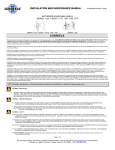

![取扱説明書[DC-2ECA/3ECAシリーズ] (2.26 MB/PDF)](http://vs1.manualzilla.com/store/data/006604585_3-200f4d6cbb2472ba30dd36ccab1dff5e-150x150.png)
